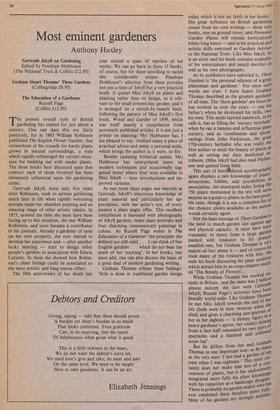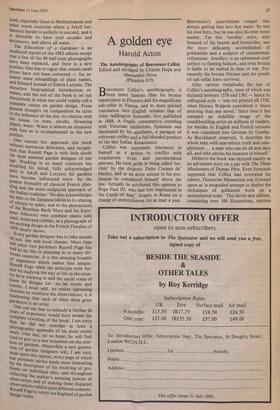Most eminent gardeners
Anthony Huxley
Gertrude Jekyll on Gardening Edited by Penelope Hobhouse (The National Trust & Collins £12.95) Graham Stuart Thomas' Three Gardens (Collingridge £9.95) The Education of a Gardener Russell Page (Collins £12.95)
The present overall style of British gardening has existed for just about a century. One can date this era fairly positively, for in 1883 William Robinson published The English Flower Garden, that cornerstone of his crusade for hardy plants grown in natural surroundings, a style which rapidly submerged the current obses- sion for bedding out with tender plants. The three books here discussed span that century: each of those involved has been immensely influential upon the gardening scene.
Gertrude Jekyll, born only five years after Robinson, took to serious gardening much later in life when rapidly worsening myopia made her abandon painting and an amazing range of other artistic talents. In 1875, around the time she must have been facing up to this situation, she met William Robinson, and soon became a contributor to his journals. Already a gardener of taste on her own property, she now started to develop her experience and — after another lucky meeting — start to design other people's gardens in association with Edwin Lutyens. In these she showed how Robin- son's plant listings could be associated to the most artistic and long-season effect.
The 50th anniversary of her death last
year started a spate of reprints of her works. We can go back to these 15 books, of course, but for those unwilling to tackle this considerable corpus Penelope Hobhouse's selection from these provides not just a taste of Jekyll but a very practical book. It quotes Miss Jekyll on plants and planting rather than on design, so is rele- vant to the small present-day garden; and it is arranged on a month-by-month basis, following the pattern of Miss Jekyll's first book, Wood and Garden of 1899, which was itself mainly a compilation from previously published articles. It is not just a primer on planting: Mrs Hobhouse has, I am pleased to say, retained many a piece of practical advice and many a personal aside, which brings the author as it were, to life.
Besides updating botanical names, Mrs Hobhouse has interpolated notes on modern techniques and occasionally sug- gested better plants than were available to Miss Jekyll — later introductions and im- proved varieties.
As one turns these pages one marvels at Gertrude Jekyll's enormous knowledge of plant material and particularly her ap- preciation, with her artist's eye, of every nuance a plant might offer. This excellent compilation is leavened with photographs of Jekyll gardens, many plant portraits and four charming contemporary paintings in colour. As Russell Page writes in The Education of a Gardener 'the principles she defined are still valid . . . I can think of few
English gardens . . . which do not bear the mark of her teaching'. In her books, one must add, one can also discern the basis of a great deal of modern gardening writing.
Graham Thomas echoes these feelings: 'little is done in traditional garden design
Spectator 11 June 1983 today which is not set forth in her books.' His great influence on British gardening comes from his own writings — three rose books, one on ground cover, and Perennial Garden Plants will remain horticultural bibles long hence — and in his practical and artistic skills exercised as Gardens Adviser to the National Trust. Like Miss Jekyll, he is an artist and his book contains examples of his watercolours and pencil sketches as well as his own photographs. As its publishers have subtitled it, Three Gardens is 'the personal odyssey of a great plantsman and gardener.' For once such words are true; I have heard Graham Thomas described as the greatest gardener of all time. The 'three gardens' are those he has worked in over the years — one his father's where he developed his skills, two his own. This multi-layered sandwich, as he calls it, has as filling the 'nursery interlude' when he ran a famous and influential plant nursery, and as 'condiments and spices' sayings from John Parkinson, the great 17th-century herbalist who was really the first author to extol the beauty of plants as well as setting out their medicinal at- tributes. (Miss Jekyll had also read Parkin- son and quoted from him).
This sort of hortiiltural autobiography again displays a rare knowledge of
attractions, foibles, and possibilities in association. An annotated index listing the 750 plants mentioned in the text will serve anyone as a guide to plants in the best possi- ble taste, though it is not a complete list of the choicest plants available as the author
would certainly agree. plants'
Not the least message of Three Gardens is the need to match garden size against age and physical capacity. It must have been traumatic to move from a large garden packed with treasures to his present smallish one, but Graham Thomas is very matter-of-fact about it — and of course he took many of the treasures with him. He ends his book discussing the plant qualities e which 'The B ea u Beauty of f n him i naonweesrSsa,y-chapter entitl- ed - d T While Graham Thomas has worked en- tirely in Britain, and the same was I believe almost entirely the case with Gertrude Jekyll, Russell Page's activities have bee Thomas literally world-wide. Like Graham Th he met Miss Jekyll towards the end of her she life (both were in their twenties when, silo, died) and gives a charming pen-portrait ; her in her eighties — 'a dumpy
-airs '
heavy gardener's apron, her vitality shin 0, from a face half concealed by two p 110Wed
straw hat'. spectacles and a battered and Ye
Graham But he differs from her and Gra tes Thomas in one important way: as he stfamy figure in at the very start 'I last had a garden ot own when I was eighteen.' This mos oar.. tainly does not make him less of a c noisseur of plants, but it has undoeuhiteedilry: integrated more fully his plant kndosw.g1 with his capacities as a landscape There is probably no garden maker w _on!" ever combined these faculties moarerchf ec Most of his gardens are strongly
tural, especially those in Mediterranean and other warm countries where a Jekyll her- baceous border is unlikely to succeed, and it is desirable to have cool arcades and enclosures, and above all water.
The Education of a Gardener is an unaltered reprint of the 1962 edition except that a few of the 49 half-tone photographs have been replaced, and there isa new preface. One has to regret that certain small errors have not been corrected — for in- stance some misspellings of plant names, and Edward instead of Edwin Lutyens. The attractive biographical introduction re- mains, and the rest of the book is set out discursively in what one could readily call a complete canon on garden design. From general thoughts on composition he turns to the influence of the site, its relation with the house, to trees, shrubs, flowering Plants, water. Water is almost an obsession with him as is re-emphasised in the new preface.
One cannot but approach this book without enormous deference, and recogni- tion that Russell Page is with little doubt the most eminent garden designer of our age. Working in so many countries has modified his initial, fully acknowledged debt to Jekyll and Lutyens; his gardens have become influenced more 'by the greater formality of classical French plan-
ning and the more sculptural approach of the Italian tradition.' He also acknowledges his debt to the Japanese idiom in its relating of objects to space, and to the abstractions of the Brazilian Burle Marx and his Euro- pean followers who combine plants with sand, stone and cobbles, as a photograph of his exciting design at the French Floralies of 1959 clearly shows. Every garden designer has to take acount of Soil, site and local climate. More than °ur other two gardeners Russell Page has had to do this in planning in so many dif- ferent countries. It is this amazing breadth of experience which makes him unique. Russell Page takes the principle even fur- ther by studying the way of life in the coun- trY he is working in and the social scene of those he designs for. As he works and travels, I must add, he makes lightening sketches to reinforce his observations; it is fascinating that each of these three great gardeners is an artist.
One can see that to embody a further 20 Years of experience would have meant the complete rewriting of the book. I am sorry that he did not consider at least a Photographic appendix of his more recent work. One day, let us hope, he will find time to give us a new testament on the crea- tion of gardens. Meanwhile a new genera- tion of garden designers will, I am sure, seize upon this reprint, every page of which has pertinent advice made more interesting by the description of his resolving of pro- blems on individual sites, and throughout reflecting the author's amazing powers of observation and of making these disparate observations valid in quite different contexts. Russell Page is surely the Raphael of garden design today.











































 Previous page
Previous page